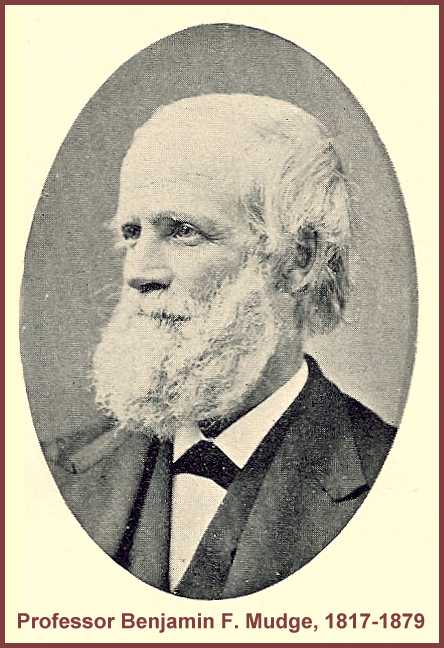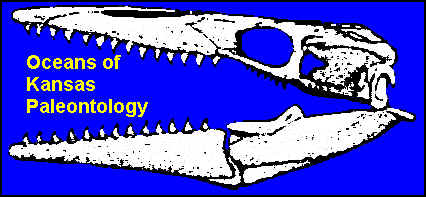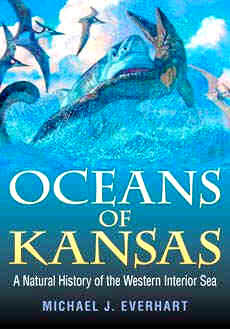ABSTRACTS OF THE 2008 PRESENTATIONS
Paleontology Symposium - Michael Everhart,
Chair
Beckemeyer, R.
J., Museum Associate, Natural History Museum (Entomology Division), University of Kansas,
Lawrence. MORPHOLOGICAL PARAMETERS OF
WELLINGTON FORMATION INSECT WINGS. Insect wing
morphology can be characterized by various geometric parameters, such as length and width. Traditional measures of wings as aerodynamic
surfaces, such as Aspect Ratio, a measure of the slenderness of a wing, can be computed
for insect wings as well. In 1984
biomechanicist C. P. Ellington of Cambridge University developed a series of measures of
the spanwise distribution of wing width, showed that the measures were allometrically
related, and discussed how they might be interpreted in terms of flight parameters. A sample of Wellington Formation insect wings have
been analyzed; these data will be presented and comparisons of these morphological
parameters for the Wellington Formation Permian insect assemblage will be compared with
Ellington's data for extant insects.
Martin,
L. D. and *D. A. Burnham, Department of Ecology and Evolutionary Biology and Museum of
Natural History (BRC), University of Kansas. PREDATORY
BEHAVIOR IN A FOUR WINGED DINOSAUR-LIKE BIRD. The four-winged dinosaur-like bird Microraptor, has flight feathers on its feet fully
comparable to the primary flight feathers of the front wing.
These feathers preclude any hope of normal progression on the ground and
establish that it was completely arboreal. Similar-sized,
but unfeathered predators, the compsognathid dinosaurs, (Compsognathus, Sinosauropteryx), are often found with
well-preserved skeletons of prey (lizards, small mammals) in the stomach region. This has occurred in nearly half of the discoveries
(at least eight) of these animals, indicating that they typically caught small terrestrial
animals and swallowed them whole. We have examined over twenty skeletons of cf. Microraptor without finding any evidence of their
prey suggesting that they dismembered it, swallowing chunks of flesh with very little
accidental inclusion of bones in the process. In
that case the prey was probably larger in comparison to the predator than that swallowed
by the compsognathids. We suggest that
microraptors were specialized predators on other arboreal animals and that they
specialized on contemporary birds many of which had claws on the hands for tree trunk
climbing. We think that they caught birds (Confusciusornis) in the process of climbing a tree
trunk, glided to a point behind it, seized and killed it, then carried the carcass to a
branch where it was systematically dismembered.
*Elder, R. and
L. D. Martin, Department of Ecology and Evolutionary Biology, University of Kansas LONGISQUAMA INSIGNIS AND THE ORIGIN OF AVIAN
PLUMAGE. The discovery of the four-winged
feathered dromaeosaur, Microraptor, fulfills
Beebe’s prediction that bird flight originated in a sprawling four-winged glider. One of the criticisms leveled by Heilmann against
Beebe was the existence of elongated feathers in the spinal tract of young pigeons
paralleling those on the femoral tract used by Beebe as ontogenetic support for his model
of flight origins. However Heilmann’s
criticism lost most of its force with the discovery that the Lower Cretaceous
dinosaur-like bird, Microraptor had the femoral
tract modified into a fully formed hind wing just as Beebe had suggested. Heilmann’s comment seems prophetic when the
elongated spinal tract feathers forming the unique thoracic wing of the small Triassic
archosaur, Longisquama are taken into
consideration. These elongate feathers are
similar to and probably serially homologous with the elongated feathers on the tail of Archaeopteryx.
As suggested by Martin, flight may have arisen in a small sprawling arboreal
glider with a thoracic wing. As feathers
developed on the front legs and a power stroke developed to facilitate landings, the
thoracic wing was reduced with the tail of Archaeopteryx
representing a later stage in that pattern of reduction.
Everhart,
M.J., Sternberg Museum of Natural History Fort
Hays State University. PROBABLE CAUSE OF DEATH
OF THE HOLOTYPE SPECIMEN OF TYLOSAURUS KANSASENSIS
(SQUAMATA; MOSASAURIDAE) FROM THE SMOKY HILL CHALK, WESTERN KANSAS. Mosasaurs are large marine reptiles that flourished
in Earth’s oceans during the last 25 million years of the Late Cretaceous. The
largest species grew to adult lengths in excess of 15 m near the end of the Maastrichtian.
Aside from Great white-sized sharks such as Cretoxyrhina
mantelli, there are no other marine species known from that time which could challenge
the role of mosasaurs as apex predators. From the evidence of the injuries observed on the
remains of mosasaurs since their discovery, however, it appears that they occasionally
fought with or were attacked by other mosasaurs. Sometimes the injuries incurred in this
combat were non-fatal and healed prior to the death of the mosasaur; in other specimens,
the injuries were apparently fatal. The well preserved, articulated skull, lower jaws and
cervical vertebrae of the holotype specimen of Tylosaurus
kansasensis (FHSM VP-2295) were collected from the lower Smoky Hill Chalk (Late
Coniacian) in Ellis County in 1968. The skull exhibits readily visible and non-healed
gouges on the frontal and right dentary that are attributable to the powerful bite of a
much larger mosasaur. The deep bite marks on the skull, as well as possible damage to the
neck at the base of the skull, suggest that this individual died when its skull was bitten
and crushed by another, larger mosasaur.
Falk,
A. R. (2) Department of Geology, University of Kansas. CREDIBILITY OF “UNKNOWN
THEROPOD TRACKS” WITH AVIAN CHARACTERISTICS FROM THE LATE TRIASSIC. Melchor et al. (2002, 2006) described birdlike
footprints from the late Triassic Santo Domingo Formation (Norian/Rhaetian) in northwest
Argentina that are not definitively stated to be bird tracks. Rather, they are attributed
to an unknown theropod with avian characteristics. The tracks from Santo Domingo differ
from small theropod tracks based on the angle of divarication between toes II and IV. This
angle is important in distinguishing dinosaur tracks from bird tracks since bird track
divarication angles measure approximately 100° or greater and dinosaur tracks generally
have an average angle of much less than 100° . Furthermore, no dinosaur track has an
average angle greater than 100° (Currie, 1981). These Triassic tracks have a mean angle
divarication of 115° , with a minimum angle of divarication of 87° and a maximum angle
of 137° (n=49), and are clearly not within the range of
known dinosaur track measurements. The tracks described by Melchor et al. meet other
criteria for determining bird tracks; the tracks are wider than they are long, show a
posteriorly-directed hallux impression, and are visually reminiscent of modern bird
tracks. The Melchor et al. Santo Domingo tracks extend the trace fossil record of Mesozoic
birds from the Cretaceous to the Triassic. This implies that the evolutionary origin of
birds can now be considered Triassic in age, much older than Archaeopteryx from the Jurassic Solnhofen Formation
(Kimmergian/Tithonian).
*Hageman1,
S.A., T.J. Northcutt2, and B.L. Hoffman1. 1Department of Natural and Physical
Sciences, Park University, 2Paleontologist, Mission, KS. PRELIMINARY ANALYSIS OF THE BIODIVERSITY OF THE
BONNER SPRINGS SHALE (LAGERSTÄTTEN?), PARKVILLE, MO.
Exceptionally well-preserved plants and insects occur in the Bonner Springs
Shale (Upper Pennsylvanian, Kansas City Group). The
flora is represented by 15+ genera. Odontopteris, Neuropteris, Cordaites,
and Calamites (Annularia and Asterophyllites) are commonly present with Asolanus, Aphlebia,
Alethopteris, Pecopteris, and Sphenophyllum also represented. The lycopods are represented by leaves (Lepidophylloides), microsporangiate (Lepidostrobus) and megasporangiate (Lepidostrobophyllum) cones. Fossils resembling megasporagnium have been
discovered but are interpreted as egg cases. These
cockroach oothecae are 2 cm in length and correspond with cockroach wings (2-3 cm) in the
unit. Twenty specimens of insect wings and
oothecae represent three Orders; O. Paleodictyoptera, O. Blattodea (cockroaches), and
Order Plecoptera (stonefly). The cockroach
genus Sysciophlebia is the most common with some
representing new species. The depositional
environment of the Bonner Springs Shale at this locality indicates a floodplain. Laminated deposits (sand, silt, mud) occur for 8
meters and represent a multitude of flooding events. The
best preserved specimens are associated with the finer grained sediment but the outcrop is
fossiliferous throughout with the lowest meter being most productive in diversity. This locality provides the opportunity to
reconstruct a tropical biome for the flora and the insect population associated with it
and may eventually reveal additional insects or arthropods making its classification as a
lagerstätten plausible.
Morales, M.
and K. Moore, Earth Science Department, Emporia State University. FOSSIL MARINE INVERTEBRATES FROM THE UPPER
PENNSYLVANIAN (VIRGILIAN) SEVERY SHALE FORMATION NEAR MELVERN LAKE, KANSAS. The Severy Shale Formation is the lowest formation
of the Sacfox Subgroup, which is the lowest subgroup of the Wabaunsee Group of Kansas. The
Severy rests unconformably on top of the Topeka Limestone Formation and is overlain by the
Howard Limestone Formation. Thus the Severy is
of Late Pennsylvanian (Virgilian) age. Although
the formation is reported to have only "sparse" fossils in its uppermost part, a
rich locality north of Melvern Lake in Osage County contains an abundant and diverse
assemblage of marine fossils. The fauna includes the following genera: fusulinid
foramiferan Triticites; rugose coral Lophophyllidium; bryozoans Fenestella, Rhombopora,
Cystoporata, Fistulipora, and Tabulipora; cephalopods Mooreoceras and Tainoceras; gastropods Worthenia, Bellerophon,
Knightites, Euphemites, Ianthinopsis,
Strobeus, Palaeozygopleura,
Straparollus, Phymatopleura, Stegocoelia, and Meekospira; bivalves Aviculopinna, Orthomyalina,
Aviculopecten, Phestia, Nuculopsis,
Parallelodon, and Astartella; brachiopods Neospirifer, Juresania,
Derbyia, Meekella,
Dictyoclostus, Marginifera, Neochonetes, Enteletes,
and Composita; echinoderms Delocrinus and uncertain echinoids; trilobites Ameura and Ditomopyge. The fauna is said to also include rare isolated
"shark teeth", but we have never collected any, and there are none in the fossil
collections of the Johnston Geology Museum at Emporia State University.
*Nabavizadeh,
A. (1), L. D. Martin, and D. A. Burnham, Department
of Ecology and Evolutionary Biology and University of Kansas Museum of Natural History
(BRC), University of Kansas. DO DEFENSIVE
STRUCTURES IN TRICERATOPS PROVE PREDATORY
BEHAVIOR IN TYRANNOSAURUS? Although the
extensive frills of ceratopsian dinosaurs are relatively thin and could never have
resisted the full biting force of a tyrannosaurid’s mouth, they may still
have provided a measure of protection. In order to bite something, the predator must first
introduce it into the mouth, and the adult Triceratops
frill extended far beyond the gape of any tyrannosaurid. The frill also extended back
beyond the vulnerable neck and upper back. Known
evidence of possible Tyrannosaurus attacks have
been limited to the posterior back and pelvic region. As long as the Triceratops kept its nose pointed at the
attacker, a tyrannosaurid would have to reach over the front of the frill to reach the
back and expose its vulnerable underbelly to the ceratopsian’s long horns. It is
clear from this scenario that the tyrannosaurid would have had to get behind the
ceratopsian, a movement that could be easily foiled by groups of ceratopsians behaving
together. It would seem that Triceratops had
evolved just the right tools to deal with giant, bipedal, predatory dinosaurs and the only
one available was Tyrannosaurus. This defensive
structure would seem to be sufficient proof that Tyrannosaurus
was an active predator, although like modern large predators, it would probably scavenge
when the opportunity presented.
*Schumacher,
B.A., Sternberg Museum of Natural History, Fort Hays State University. ON A PLIOSAUR SKULL (PLESIOSAURIA) FROM THE UPPER
CRETACEOUS OF THE NORTH AMERICAN WESTERN INTERIOR. A partial pliosaur skull in the
University of Nebraska State Museum (UNSM 50136) reveals anatomical features hitherto
unreported for the group. Possessing only circumstantial contextual information, the
specimen’s preservational character suggests origination from the Fairport Chalk of
central Kansas. Nannofossil analysis of attached matrix will provide a conclusive temporal
position. The specimen includes the muzzle and portions of the palate, minus the
premaxillae, with a maximum preserved length of 102 cm. Although perhaps not taxonomically
significant, the specimen is impressively large with an estimated restored skull length of
1.75 m. The vomers are elongate (61 cm) and bifurcate near their posterior termination,
and are overlapped extensively (24 cm) by slender extensions of the pterygoids. The latter
character has not been reported within the Plesiosauria, and given the degree of
development, may be variably present throughout the group. The internal nares are formed
by the juncture of the palatines, vomers, and maxillae. Also preserved are portions of the
posterior palatines and jugals. Configuration of the palatal elements, in particular the
elongate vomers and position of the internal nares contrasts markedly with Brachauchenius. Likewise, the specimen’s
elongate muzzle and homodont dentition are not similar to Kronosaurus or Plesiopleurodon. With no clearly similar material
for reference, the specimen may represent an undescribed taxon. Future research will
likely reveal a greater diversity of Cretaceous pliosaurs than currently known.
*Williams,
D.W.(3), Department of Ecology and Evolutionary Biology, University of Kansas. USING LANDMARK DATA FROM THE FIRST LOWER MOLAR TO
DISCRIMINATE NORTHERN GREAT PLAINS MICROTUS
SPECIES. The identification of Microtus teeth in fossil sites is desirable
because of their use as ecological indicators and morphological specificity. Microtus
species are differentiated using the first lower molar (m1) with additional
characteristics (biogeography, other teeth, skull characters, etc.) as needed. The m1 is often recovered as an isolated tooth
however, so identifications based on that tooth alone are valuable. Landmark data have previously been used to
successfully discriminate M. pennsylvanicus and M. xanthognathus in fossil samples. I extended this data set to include six more Microtus species and used the landmark data in a
discriminant function to identify Pleistocene Microtus
fossils. After jackknifing the data, the
discriminant function correctly placed 87% of 130 modern specimens. When the problematic species M. montanus was excluded, the successful
identification rate increased to 90%.





